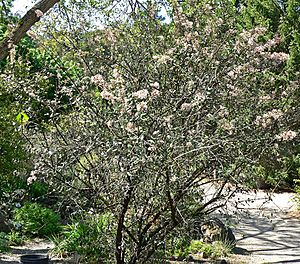Hoaryleaf ceanothus facts for kids
Quick facts for kids Hoaryleaf ceanothus |
|
|---|---|
 |
|
| Scientific classification | |
| Genus: |
Ceanothus
|
| Species: |
crassifolius
|
The Hoaryleaf Ceanothus (scientific name: Ceanothus crassifolius) is a type of flowering shrub. It's often called "hoaryleaf" because its leaves have a fuzzy, whitish look, like they're covered in frost. This plant is native to the coastal mountains of southern California. You can also find it growing in Baja California, which is just south of the border.
Where It Grows: Its Habitat
The Hoaryleaf Ceanothus loves to grow in a special kind of natural area called California chaparral. This habitat is found along the coast and in the mountains of California. It's a place with many shrubs and small trees.
Some other plants that often grow near the Hoaryleaf Ceanothus include Toyon (Heteromeles arbutifolia) and Hollyleaf cherry (Prunus ilicifolia). You can spot this plant in several mountain ranges. These include the Southern California Coast Ranges, the Transverse Ranges, and the Peninsular Ranges.
What It Looks Like: Description
The Hoaryleaf Ceanothus is an upright, spreading shrub. It can grow quite tall, sometimes reaching over 3 meters (about 10 feet) in height. Its branches can become very long. The younger twigs on the plant are soft and fuzzy. They are covered with white or light brown hairs.
The leaves of this plant are small and stay green all year round. They have widely spaced teeth along their edges. The underside of the leaves is lighter in color and also covered with tiny hairs. This is where the "hoaryleaf" name comes from!
Flowers and Fruit
The plant's tiny white flowers grow in clusters. These flower clusters are small and round. They are found on short stalks, less than three centimeters long. Sometimes, these flowers are so dense that they thickly cover the branches. Other times, they might be more spread out. While usually white, the flowers can sometimes have a slight yellowish or pink tint.
After the flowers bloom, the plant produces a small fruit. This fruit is a horned capsule. It is less than a centimeter wide.


